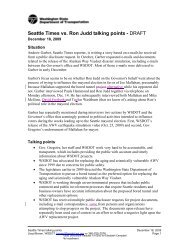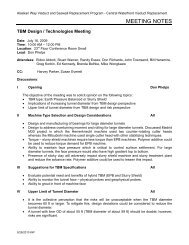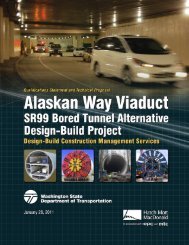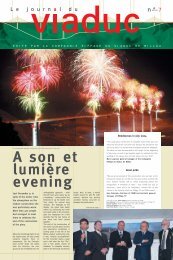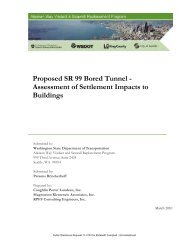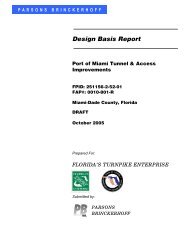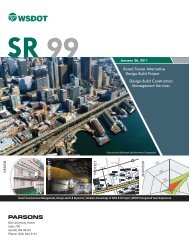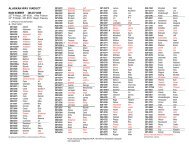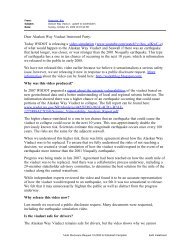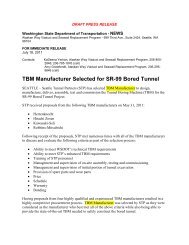Overview of NFPA 502 Standard for Road Tunnels ... - SCATnow
Overview of NFPA 502 Standard for Road Tunnels ... - SCATnow
Overview of NFPA 502 Standard for Road Tunnels ... - SCATnow
- No tags were found...
You also want an ePaper? Increase the reach of your titles
YUMPU automatically turns print PDFs into web optimized ePapers that Google loves.
MAINTAINING A TENABLEENVIRONMENTThe 2008 Edition includes a complete revision to theannex material relating to tenable environment. Thisis intended to correlate with similar guidance materialin <strong>NFPA</strong> 130, <strong>Standard</strong> on Fixed GuidewayTransit and Passenger Rail Systems. The purpose <strong>of</strong>the annex is to provide guidelines <strong>for</strong> the evaluation<strong>of</strong> tenability within the tunnel evacuation paths. Currenttechnology is capable <strong>of</strong> analyzing and evaluatingall unique conditions <strong>of</strong> each path to provideproper ventilation <strong>for</strong> pre-identified emergency conditions.The same ventilating devices might or mightnot serve both normal operating conditions and preidentifiedemergency requirements. The goals <strong>of</strong> theventilation system, in addition to addressing fire andsmoke emergencies, are to assist in the containmentand purging <strong>of</strong> hazardous gases and aerosols such asthose that could result from a chemical/biologicalrelease.Environmental conditions, geometric considerations,and time considerations should be taken intoaccount. Following are some factors that should be consideredin maintaining a tenable environment <strong>for</strong> periods<strong>of</strong> short duration.Heat EffectsExposure to heat can lead to life threat three basic ways:• Hyperthermia• Body surface burns• Respiratory tract burnsFor use in the modeling <strong>of</strong> life threat due to heat exposurein fires, it is necessary to consider only two criteria—thethreshold <strong>of</strong> burning <strong>of</strong> the skin and theexposure at which hyperthermia is sufficient to causemental deterioration and thereby threaten survival.Air Carbon Monoxide ContentAir carbon monoxide (CO) content should be as follows:• Maximum <strong>of</strong> 2000 ppm <strong>for</strong> a few seconds• Averaging 1150 ppm or less <strong>for</strong> the first 6 minutes<strong>of</strong> the exposure• Averaging 450 ppm or less <strong>for</strong> the first 15 minutes<strong>of</strong> the exposure• Averaging 225 ppm or less <strong>for</strong> the first 30 minutes<strong>of</strong> the exposure• Averaging 50 ppm or less <strong>for</strong> the remainder <strong>of</strong> theexposureThese values should be adjusted <strong>for</strong> altitudes above984 m (3000 ft).Smoke Obscuration LevelsSmoke obscuration levels should be continuouslymaintained below the point at which a sign internallyilluminated at 80 lx (7.5 ft-candles) is discernible at30 m (100 ft) and doors and walls are discernible at10 m (33 ft).Air VelocitiesAir velocities in the enclosed tramway should begreater than or equal to 0.76 m/s (150 fpm) and lessthan or equal to 11.0 m/s (2200 fpm).Noise LevelsNoise levels should be a maximum <strong>of</strong> 115 dBA <strong>for</strong> afew seconds and a maximum <strong>of</strong> 92 dBA <strong>for</strong> the remainder<strong>of</strong> the exposure.TRANSPORT OF REGULATED ANDUNREGULATED CARGOESRecent road tunnel fires suggest that goods traditionallynot characterized as ‘hazardous’; i.e. flour andmargarine (1999 Mont Blanc Tunnel), paint (1999Gothard Tunnel), and tires (2005 Frejus Tunnel),may constitute a greater risk to tunnel users and tunnelstructures than expected. As a result Chapter 13Control <strong>of</strong> Hazardous Materials has been re-titledRegulated and Unregulated Cargoes to provide guidanceto tunnel operators, first responders anden<strong>for</strong>cement <strong>of</strong>ficials on developing rules regardingany and all cargoes allowed passage through a particularroad tunnel facility.The authority having jurisdiction must adoptrules and regulations that apply to the transportation<strong>of</strong> regulated and unregulated cargoes. Design andplanning <strong>of</strong> the facility must address the potentialrisk presented by regulated and unregulated cargoes.When developing vehicle cargo regulations <strong>for</strong>a particular road tunnel facility, fire, accident, andresearch experience <strong>of</strong> the vehicles and cargo <strong>of</strong> thetype expected within the tunnel—and particularly <strong>of</strong>goods and vehicles not normally characterized ashazardous or otherwise regulated—should be considered.Some types <strong>of</strong> cargoes not normally consideredhazardous may in certain circumstances inconfined spaces within tunnels behave as, or equivalentto, hazardous materials in terms <strong>of</strong> the rate <strong>of</strong>fire growth, the intensity <strong>of</strong> the fire, discharge <strong>of</strong>noxious materials, destruction to infrastructure, andthreat to users’ safety.In developing regulations, the following mustbe addressed:1. Population density2. Type <strong>of</strong> highway3. Types and quantities <strong>of</strong> hazardous materials192




